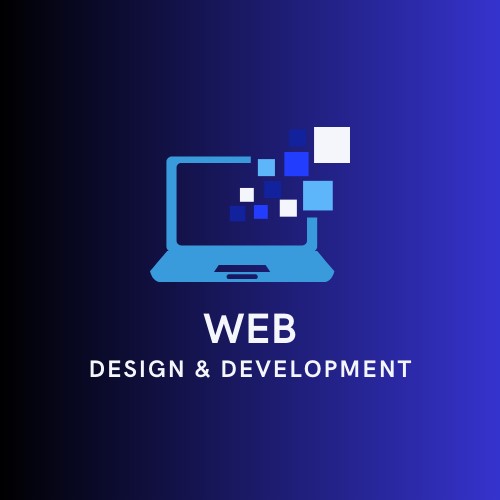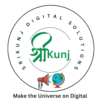Web Design And Development
Web design and development both are essential for creating a successful and effective website. Web design is the process of creating the look and feel of websites whereas web development involves the technical implementation of the website’s structure and functionality.

1. Web Design and Development (Word Press Basic website)
*(INR 7999 / USD 200)
Web design and development for a WordPress basic website comprising of
- Website Design: Creating visually appealing and intuitive user interfaces that are responsive across devices (desktops, tablets, and mobiles).
- Web Development: Building custom functionalities tailored to specific business needs.
- Google form
- Content creation
- Number of page: (1- 3)
- Google search console
- Google AdSense
- Google Analytics
- Social Sharing Buttons
- User friendly
Add-On charges
- Domain (Mandatory)
- Hoisting (Mandatory)
- SSL certificate (mandatory)
- Plugins (if applicable)
- Chat boat (Live chat) (Optional)
- Call from website (Optional)
2. Web Design and Development (Word press E-commerce website)
*(INR 15999 / USD 400)
Web design and development for a wordpress E-commerce website comprising of
- Website Design: Creating visually appealing and intuitive user interfaces that are responsive across devices (desktops, tablets, and mobiles).
- Platform Selection: Choosing the right e-commerce platform (like Shopify, WooCommerce etc.) based on the client’s requirements and scalability needs.
- Custom Development: Building custom functionalities tailored to specific business needs, such as custom product configurations, payment gateways, or subscription models.
- Shopping Cart Development: Designing and integrating a seamless and user-friendly shopping cart experience that makes it easy for customers to add and manage items.
- Payment Gateway Integration: Integrating secure and reliable payment gateways to facilitate smooth transactions (PayPal, Stripe, etc.).
- Database Management: Setting up and managing databases for product information, customer details, orders and inventory.
- Google form
- Number of page: (1- 3)
- Google search consol
- Google AdSense
- Google Analytics
- Social Sharing Buttons
- User friendly
Add-On charges
- Domain (Mandatory)
- Hoisting (Mandatory)
- Security Implementation: Implementing robust security measures to protect sensitive customer data, including SSL certificates, encryption and secure payment processing (mandatory)
- Plugins (if applicable)
- Chat boat (Live chat) (Optional)
- Call from website (Optional)
What Is Web Design?
Web design is the process of creating the look and feel of websites. It involves deciding how a website will appear to users, including layout, colors, fonts, and images
Best Web Design Software Tools
The “best” web design software tools can vary depending on user’s preferences, project requirements, and skill levels. However, here are some popular tools across different categories,
- Adobe Creative Cloud (Adobe XD, Photoshop, Illustrator): It is specifically designed for UI/UX design, while Photoshop and Illustrator are handy tools used for graphic design, including web design elements.
- Sketch: Its Popular among designers for its intuitive interface and focus on UI/UX design. It’s Mac-only software.
- Figma: A cloud-based design tool that enables collaboration in real-time, it’s great for team projects. It’s accessible on several platforms.
- InVision Studio: Popular for its powerful prototyping and animation features, suitable for creating interactive web designs.
- Affinity Designer: Offers a professional-grade alternative to Adobe software, with a one-time purchase model instead of a subscription.
- Canva: Generally useful for beginners or those without design experience, offering a user-friendly interface.
- Bootstrap: A front-end framework for developing responsive and mobile-first websites using HTML, CSS, and JavaScript. It provides pre-built components and layouts.
- WordPress with Elementor or Divi: WordPress is a popular content management system (CMS), and Elementor or Divi are drag-and-drop page builders that allow for visual web design within WordPress.
- Wix or Squarespace: These are website builders that offer a user-friendly interface and drag-and-drop functionality, suitable for those who prefer a more clear-cut approach without coding.
- Sublime Text or Visual Studio Code: These are text editors preferred by many developers for writing HTML, CSS, and JavaScript code directly.
Finally, the best tool depends on your specific requirements, preferences, and level of expertise. It’s often a good idea to try out a few different options to see which one works best for you.
What Is Web Development ?
Web development is the process of creating websites or web applications that are accessible via the internet or an intranet. It involves various tasks, including web design, web content development, client-side/server-side scripting, network security configuration, and web server administration
Key Components In Web Development
- Front-end Development: This involves creating the visual and interactive parts of a website or web application that users see and interact with directly. It includes HTML (Hypertext Markup Language), CSS (Cascading Style Sheets), and JavaScript programming.
- Back-end Development: This is about building the hidden parts of a website or web app that make it work smoothly. It’s like the engine of a car – you can’t see it, but it’s what powers everything. This involves using coding languages like PHP, Python, or Ruby, and databases like MySQL, PostgreSQL, or MongoDB to store and manage data.
- Full-stack Development: Developers who work on both the front-end and back-end aspects of a website or web application are called full-stack developers.
- Web Design: This involves creating the layout, visual appearance, and user experience of a website or web application. It includes aspects like color schemes, typography, and user interface design.
- Web Content Development: This involves creating text, images, videos, and other multimedia elements that are presented on a website or web application. Content development is essential for engaging users and conveying information effectively.
- Web Server Configuration and Management: This involves setting up and managing the web server where the website or web application will be hosted. It includes tasks like domain registration, DNS (Domain Name System) configuration, SSL (Secure Sockets Layer) certificate installation, and server security configuration.
Overall, web development encompasses a wide range of disciplines and skills, and it requires collaboration between designers, developers, content creators, and system administrators to create successful websites and web applications.
*Note
All the pricing plans above for Web design and development are excluded from GST charges (18%) and Add-On charges eg Cost for Domain, Hoisting, SSL certificate, Plugins, Chat boat from the website (Live chat), WhatsApp from the website, calls from the website, PPC advertising/Advertising platforms (if any) not included in any of these packages, these will be charged as per concerned service provider’s tariff}
FAQs
A WordPress Basic website is a simple site created using the WordPress platform, which is extensively used for building websites. It’s user-friendly, making it accessible even for those without advanced technical skills.
It includes:
- Home page: It introduces the website and its purpose.
- About page: Provides information about the website owner or organization.
- Contact page: Offers contact details or a form for visitors to reach out.
- Blog: A section for posting regular updates, articles, or news.
- Navigation menu: Helps visitors move between different pages.
- Customization: WordPress provides various themes and plugins to personalize the site’s appearance and functionality.
Basically, a WordPress Basic website is an easy-to-manage online presence suitable for individuals, small businesses, or organizations looking for a web presence with very less development costs.
A WordPress e-commerce website is an online store created using WordPress. It’s where businesses can sell their products or services directly to customers over the Internet.
In a WordPress e-commerce setup, you’ll find:
- Product Pages: Each product gets its page with all the details like price, description, and images.
- Shopping Cart: Customers can add products they want to buy to their cart and then proceed to checkout.
- Checkout Process: Secure payment gateways come into play, allowing customers to pay for their purchases using various methods.
- Inventory Management: There are tools to help businesses keep track of how much stock they have so they don’t accidentally oversell.
- Order Management: The admin dashboard lets store owners see and handle orders, process refunds, and communicate with customers.
- Shipping Options: Integration with shipping carriers helps calculate shipping costs and print labels for sending out orders.
- Security: Making sure all transactions are secure and customer data is protected is a big part of running an e-commerce site.
Most WordPress e-commerce websites use plugins like WooCommerce to add these features to their WordPress site. These plugins are like add-ons that provide the ability for a WordPress site to function as an online store without the need for everything from scratch.
